Dementia Care: Understanding Needs and Implementing Effective Interventions
VerifiedAdded on 2023/06/12
|17
|4442
|72
AI Summary
This paper analyzes the needs of dementia patients and effective interventions. It focuses on the implementation of music therapy as a person-centered intervention for Mr. A, a patient experiencing severe stages of dementia.
Contribute Materials
Your contribution can guide someone’s learning journey. Share your
documents today.
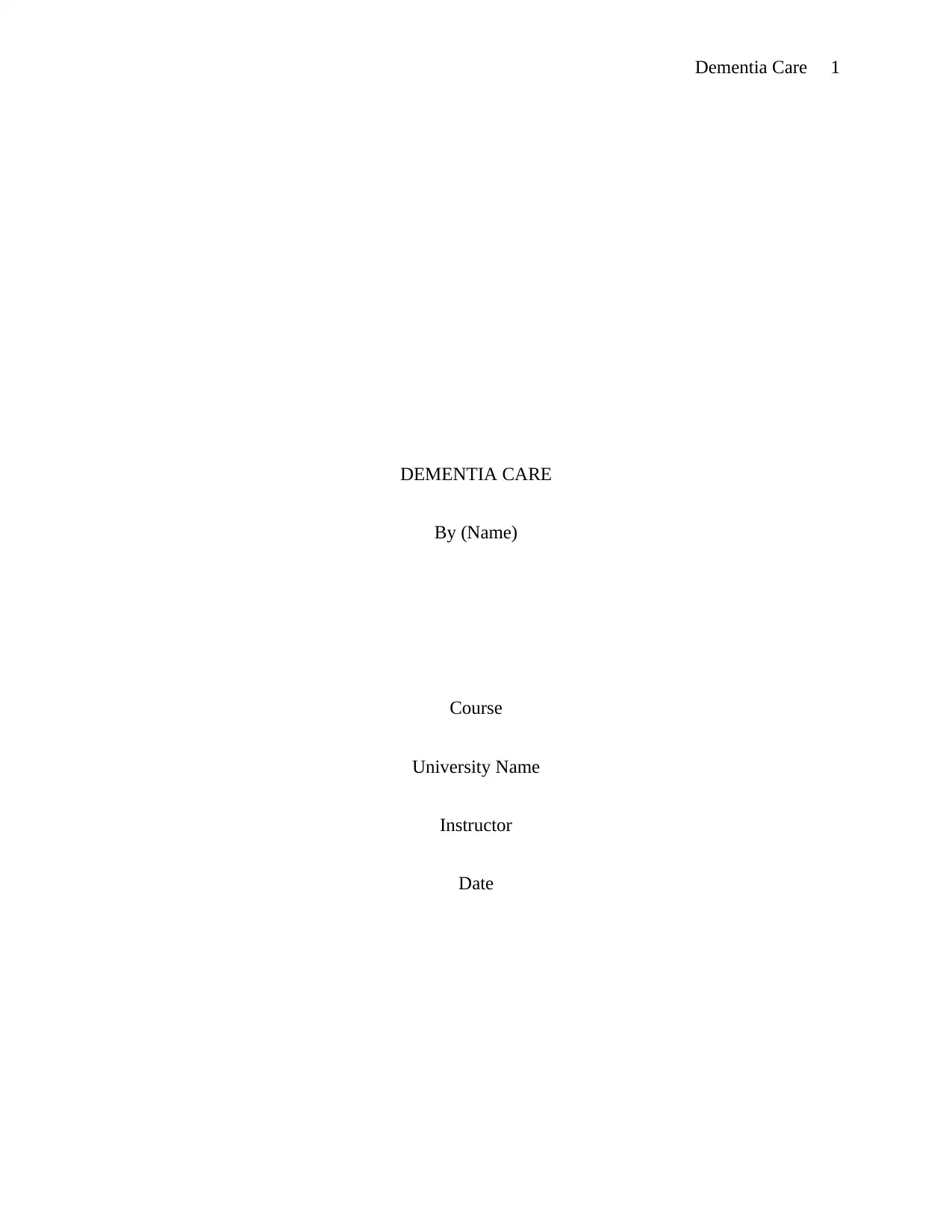
Dementia Care 1
DEMENTIA CARE
By (Name)
Course
University Name
Instructor
Date
DEMENTIA CARE
By (Name)
Course
University Name
Instructor
Date
Secure Best Marks with AI Grader
Need help grading? Try our AI Grader for instant feedback on your assignments.

Dementia Care 2
Dementia Care
Introduction
With an aging society, dementia has increasingly raised major concerns for policy makers
and health care providers and in most cases, where there is need to determine the best possible
care that that should be provided in order to realize better patient outcomes. Dementia further
presents a number of social and psychological effects to the affected individuals among them
including; decreased self-esteem, social isolation, withdrawal from family relationships, reduced
ability to undertake daily activities, and an overall decline in the individual’s quality of life
(Buettner et al, 2016, p. 5). To the family or rather caregivers, dementia may also create
considerable psychological and emotional challenges especially with the experienced
overwhelming difficulties associated with providing care to demented individuals. With severe
stages of dementia, individuals may exhibit extreme behavioral changes comprising of agitation
behaviors where the individual is restless and displays aggressive tendencies (Forbes & Neufeld,
2008, p. 11).
This paper seeks to understand the needs and experiences of Mr. A, a patient currently
experiencing severe stages of dementia, and therefore analyze the implementation plan of the
most suitable intervention method. In light of this purpose, the paper firstly details the biography
of the patient and analyzes his needs based on the assessment model provided by Kitwood
(1993). The second section details the available literature on various methods that are used in the
treatment of dementia. The third section discusses the implementation plan and the evaluation
approaches that were used to determine how Mr. A responded to the intervention. The final
Dementia Care
Introduction
With an aging society, dementia has increasingly raised major concerns for policy makers
and health care providers and in most cases, where there is need to determine the best possible
care that that should be provided in order to realize better patient outcomes. Dementia further
presents a number of social and psychological effects to the affected individuals among them
including; decreased self-esteem, social isolation, withdrawal from family relationships, reduced
ability to undertake daily activities, and an overall decline in the individual’s quality of life
(Buettner et al, 2016, p. 5). To the family or rather caregivers, dementia may also create
considerable psychological and emotional challenges especially with the experienced
overwhelming difficulties associated with providing care to demented individuals. With severe
stages of dementia, individuals may exhibit extreme behavioral changes comprising of agitation
behaviors where the individual is restless and displays aggressive tendencies (Forbes & Neufeld,
2008, p. 11).
This paper seeks to understand the needs and experiences of Mr. A, a patient currently
experiencing severe stages of dementia, and therefore analyze the implementation plan of the
most suitable intervention method. In light of this purpose, the paper firstly details the biography
of the patient and analyzes his needs based on the assessment model provided by Kitwood
(1993). The second section details the available literature on various methods that are used in the
treatment of dementia. The third section discusses the implementation plan and the evaluation
approaches that were used to determine how Mr. A responded to the intervention. The final
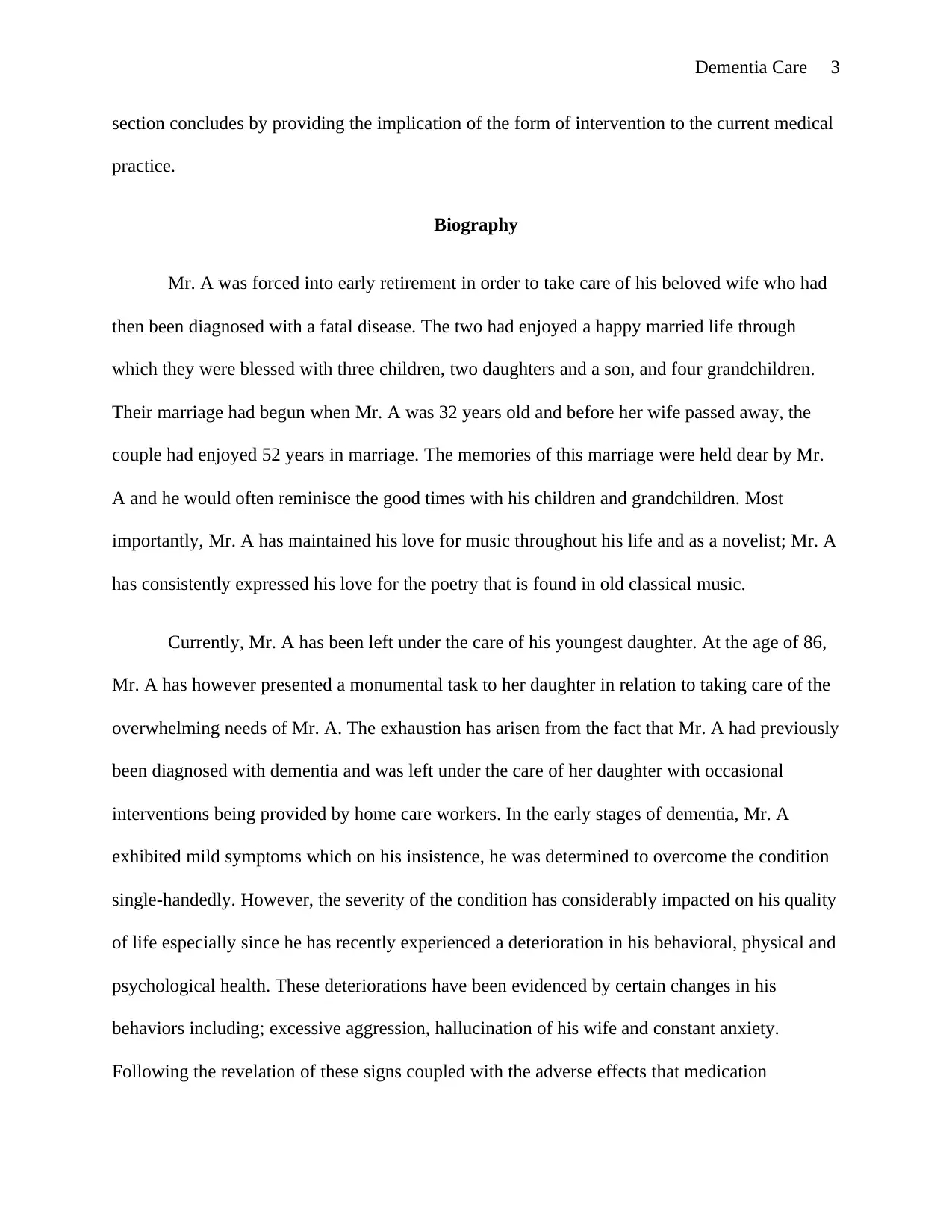
Dementia Care 3
section concludes by providing the implication of the form of intervention to the current medical
practice.
Biography
Mr. A was forced into early retirement in order to take care of his beloved wife who had
then been diagnosed with a fatal disease. The two had enjoyed a happy married life through
which they were blessed with three children, two daughters and a son, and four grandchildren.
Their marriage had begun when Mr. A was 32 years old and before her wife passed away, the
couple had enjoyed 52 years in marriage. The memories of this marriage were held dear by Mr.
A and he would often reminisce the good times with his children and grandchildren. Most
importantly, Mr. A has maintained his love for music throughout his life and as a novelist; Mr. A
has consistently expressed his love for the poetry that is found in old classical music.
Currently, Mr. A has been left under the care of his youngest daughter. At the age of 86,
Mr. A has however presented a monumental task to her daughter in relation to taking care of the
overwhelming needs of Mr. A. The exhaustion has arisen from the fact that Mr. A had previously
been diagnosed with dementia and was left under the care of her daughter with occasional
interventions being provided by home care workers. In the early stages of dementia, Mr. A
exhibited mild symptoms which on his insistence, he was determined to overcome the condition
single-handedly. However, the severity of the condition has considerably impacted on his quality
of life especially since he has recently experienced a deterioration in his behavioral, physical and
psychological health. These deteriorations have been evidenced by certain changes in his
behaviors including; excessive aggression, hallucination of his wife and constant anxiety.
Following the revelation of these signs coupled with the adverse effects that medication
section concludes by providing the implication of the form of intervention to the current medical
practice.
Biography
Mr. A was forced into early retirement in order to take care of his beloved wife who had
then been diagnosed with a fatal disease. The two had enjoyed a happy married life through
which they were blessed with three children, two daughters and a son, and four grandchildren.
Their marriage had begun when Mr. A was 32 years old and before her wife passed away, the
couple had enjoyed 52 years in marriage. The memories of this marriage were held dear by Mr.
A and he would often reminisce the good times with his children and grandchildren. Most
importantly, Mr. A has maintained his love for music throughout his life and as a novelist; Mr. A
has consistently expressed his love for the poetry that is found in old classical music.
Currently, Mr. A has been left under the care of his youngest daughter. At the age of 86,
Mr. A has however presented a monumental task to her daughter in relation to taking care of the
overwhelming needs of Mr. A. The exhaustion has arisen from the fact that Mr. A had previously
been diagnosed with dementia and was left under the care of her daughter with occasional
interventions being provided by home care workers. In the early stages of dementia, Mr. A
exhibited mild symptoms which on his insistence, he was determined to overcome the condition
single-handedly. However, the severity of the condition has considerably impacted on his quality
of life especially since he has recently experienced a deterioration in his behavioral, physical and
psychological health. These deteriorations have been evidenced by certain changes in his
behaviors including; excessive aggression, hallucination of his wife and constant anxiety.
Following the revelation of these signs coupled with the adverse effects that medication
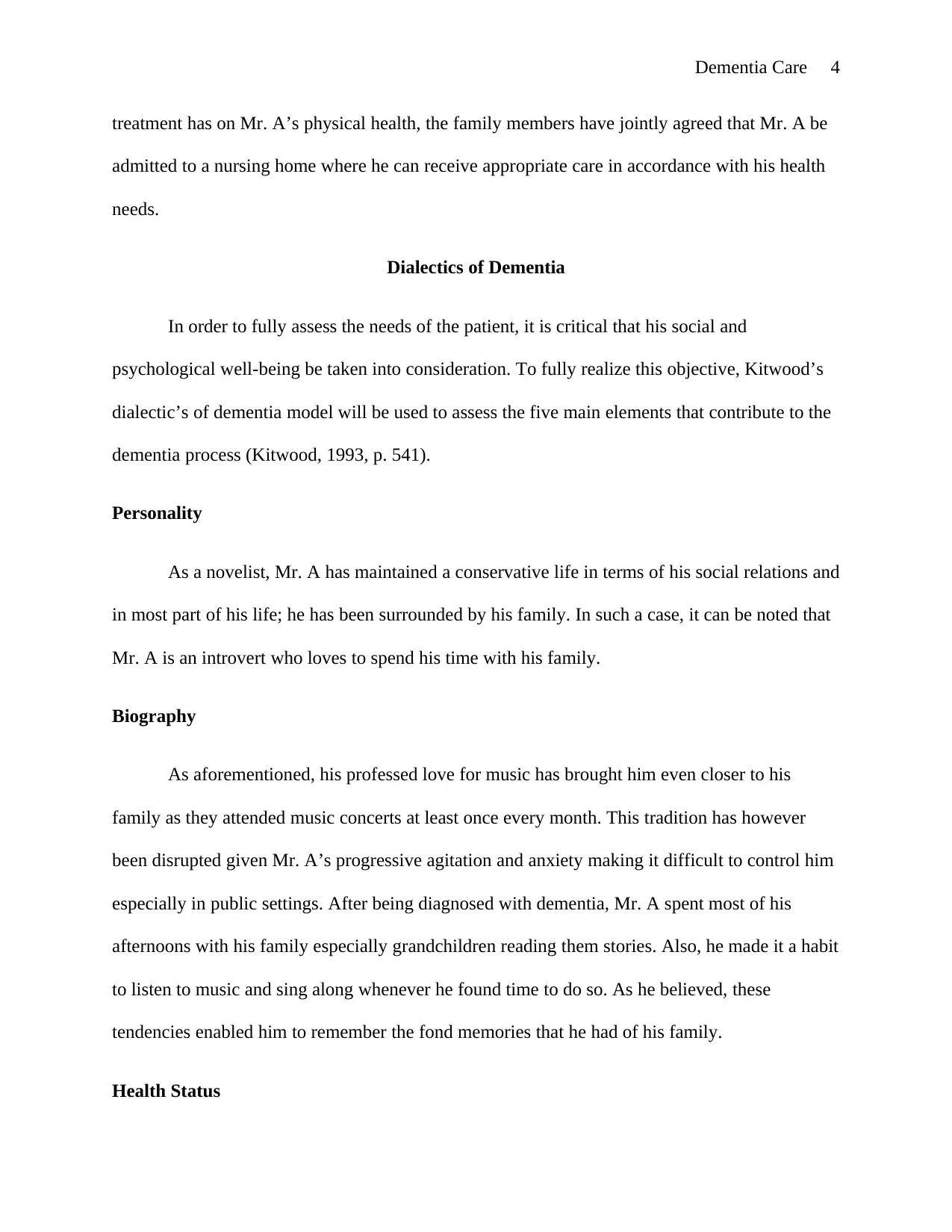
Dementia Care 4
treatment has on Mr. A’s physical health, the family members have jointly agreed that Mr. A be
admitted to a nursing home where he can receive appropriate care in accordance with his health
needs.
Dialectics of Dementia
In order to fully assess the needs of the patient, it is critical that his social and
psychological well-being be taken into consideration. To fully realize this objective, Kitwood’s
dialectic’s of dementia model will be used to assess the five main elements that contribute to the
dementia process (Kitwood, 1993, p. 541).
Personality
As a novelist, Mr. A has maintained a conservative life in terms of his social relations and
in most part of his life; he has been surrounded by his family. In such a case, it can be noted that
Mr. A is an introvert who loves to spend his time with his family.
Biography
As aforementioned, his professed love for music has brought him even closer to his
family as they attended music concerts at least once every month. This tradition has however
been disrupted given Mr. A’s progressive agitation and anxiety making it difficult to control him
especially in public settings. After being diagnosed with dementia, Mr. A spent most of his
afternoons with his family especially grandchildren reading them stories. Also, he made it a habit
to listen to music and sing along whenever he found time to do so. As he believed, these
tendencies enabled him to remember the fond memories that he had of his family.
Health Status
treatment has on Mr. A’s physical health, the family members have jointly agreed that Mr. A be
admitted to a nursing home where he can receive appropriate care in accordance with his health
needs.
Dialectics of Dementia
In order to fully assess the needs of the patient, it is critical that his social and
psychological well-being be taken into consideration. To fully realize this objective, Kitwood’s
dialectic’s of dementia model will be used to assess the five main elements that contribute to the
dementia process (Kitwood, 1993, p. 541).
Personality
As a novelist, Mr. A has maintained a conservative life in terms of his social relations and
in most part of his life; he has been surrounded by his family. In such a case, it can be noted that
Mr. A is an introvert who loves to spend his time with his family.
Biography
As aforementioned, his professed love for music has brought him even closer to his
family as they attended music concerts at least once every month. This tradition has however
been disrupted given Mr. A’s progressive agitation and anxiety making it difficult to control him
especially in public settings. After being diagnosed with dementia, Mr. A spent most of his
afternoons with his family especially grandchildren reading them stories. Also, he made it a habit
to listen to music and sing along whenever he found time to do so. As he believed, these
tendencies enabled him to remember the fond memories that he had of his family.
Health Status
Secure Best Marks with AI Grader
Need help grading? Try our AI Grader for instant feedback on your assignments.
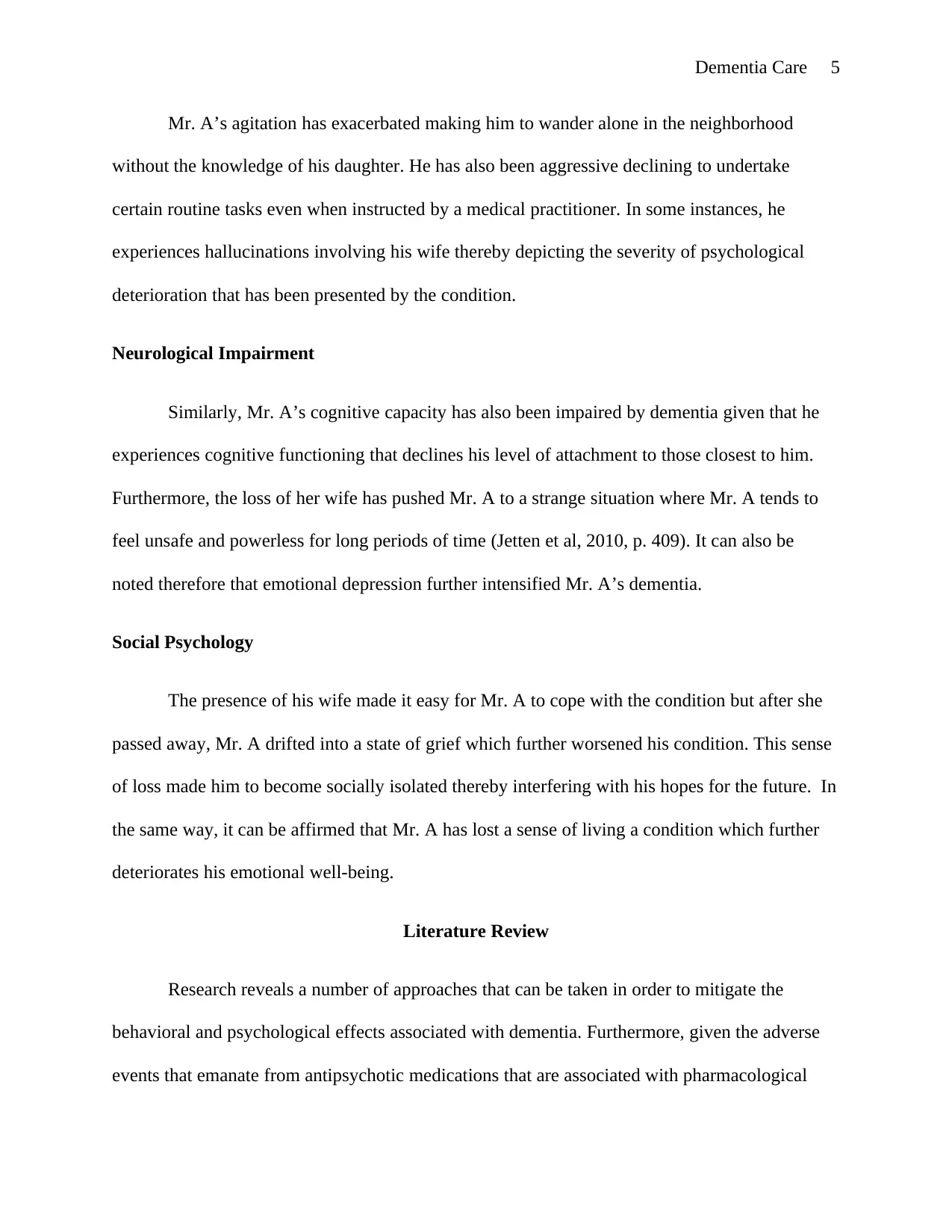
Dementia Care 5
Mr. A’s agitation has exacerbated making him to wander alone in the neighborhood
without the knowledge of his daughter. He has also been aggressive declining to undertake
certain routine tasks even when instructed by a medical practitioner. In some instances, he
experiences hallucinations involving his wife thereby depicting the severity of psychological
deterioration that has been presented by the condition.
Neurological Impairment
Similarly, Mr. A’s cognitive capacity has also been impaired by dementia given that he
experiences cognitive functioning that declines his level of attachment to those closest to him.
Furthermore, the loss of her wife has pushed Mr. A to a strange situation where Mr. A tends to
feel unsafe and powerless for long periods of time (Jetten et al, 2010, p. 409). It can also be
noted therefore that emotional depression further intensified Mr. A’s dementia.
Social Psychology
The presence of his wife made it easy for Mr. A to cope with the condition but after she
passed away, Mr. A drifted into a state of grief which further worsened his condition. This sense
of loss made him to become socially isolated thereby interfering with his hopes for the future. In
the same way, it can be affirmed that Mr. A has lost a sense of living a condition which further
deteriorates his emotional well-being.
Literature Review
Research reveals a number of approaches that can be taken in order to mitigate the
behavioral and psychological effects associated with dementia. Furthermore, given the adverse
events that emanate from antipsychotic medications that are associated with pharmacological
Mr. A’s agitation has exacerbated making him to wander alone in the neighborhood
without the knowledge of his daughter. He has also been aggressive declining to undertake
certain routine tasks even when instructed by a medical practitioner. In some instances, he
experiences hallucinations involving his wife thereby depicting the severity of psychological
deterioration that has been presented by the condition.
Neurological Impairment
Similarly, Mr. A’s cognitive capacity has also been impaired by dementia given that he
experiences cognitive functioning that declines his level of attachment to those closest to him.
Furthermore, the loss of her wife has pushed Mr. A to a strange situation where Mr. A tends to
feel unsafe and powerless for long periods of time (Jetten et al, 2010, p. 409). It can also be
noted therefore that emotional depression further intensified Mr. A’s dementia.
Social Psychology
The presence of his wife made it easy for Mr. A to cope with the condition but after she
passed away, Mr. A drifted into a state of grief which further worsened his condition. This sense
of loss made him to become socially isolated thereby interfering with his hopes for the future. In
the same way, it can be affirmed that Mr. A has lost a sense of living a condition which further
deteriorates his emotional well-being.
Literature Review
Research reveals a number of approaches that can be taken in order to mitigate the
behavioral and psychological effects associated with dementia. Furthermore, given the adverse
events that emanate from antipsychotic medications that are associated with pharmacological

Dementia Care 6
treatments, non-pharmacological and behavioral treatments have been used as first line therapy
to control effects of dementia. These forms of therapy primarily include; music therapy, light
therapy, animal assisted therapy and massage amongst others (Smith, 2014, p. 1). However, there
exists limited literature regarding the effectiveness of these approaches aside from music therapy
in which most studies have focused on. As such, various researches have provided credible data
that substantiate the effectiveness of music therapy in controlling the behavioral and
psychological impacts associated with dementia (Gerdner & McBride, 2015, p. 2).
For instance, study by Poli et al (2017) revealed that music therapy has positive cognitive
effects on individuals who have been diagnosed with dementia. In the study involving a
systematic review of more than 100 studies, it was evident that there are beneficial effects on
active music therapy on global cognition (Poli et al, 2017). Study by McDermott et al (2014) also
reveals that music therapy provides significant importance top both the patient as well as their
caregivers inclusive of the medical personnel and the patient’s family. In this light, this study
illustrates that music supports personal psychology of people suffering from dementia and also
support the social psychology of the care home environment (McDermott et al, 2014, p. 708).
The benefits associated with music therapy as a form of intervention for individuals
suffering from dementia has been generalized into diverse functions. For example, study reveals
that in comparison to other forms of treatment especially those comprising of pharmacological
medication, music therapy has been found to be less costly thereby easing the financial burden
incurred in health care cost to the patient and their families (Osman, Tischler & Schneider, 2016,
p. 1327). As aforementioned, studies have also well documented the effectiveness of music
therapy intervention as a therapeutic rehabilitation approach that reduces behavioral disturbances
that are common among persons with dementia. Alternatively, music therapy has also been
treatments, non-pharmacological and behavioral treatments have been used as first line therapy
to control effects of dementia. These forms of therapy primarily include; music therapy, light
therapy, animal assisted therapy and massage amongst others (Smith, 2014, p. 1). However, there
exists limited literature regarding the effectiveness of these approaches aside from music therapy
in which most studies have focused on. As such, various researches have provided credible data
that substantiate the effectiveness of music therapy in controlling the behavioral and
psychological impacts associated with dementia (Gerdner & McBride, 2015, p. 2).
For instance, study by Poli et al (2017) revealed that music therapy has positive cognitive
effects on individuals who have been diagnosed with dementia. In the study involving a
systematic review of more than 100 studies, it was evident that there are beneficial effects on
active music therapy on global cognition (Poli et al, 2017). Study by McDermott et al (2014) also
reveals that music therapy provides significant importance top both the patient as well as their
caregivers inclusive of the medical personnel and the patient’s family. In this light, this study
illustrates that music supports personal psychology of people suffering from dementia and also
support the social psychology of the care home environment (McDermott et al, 2014, p. 708).
The benefits associated with music therapy as a form of intervention for individuals
suffering from dementia has been generalized into diverse functions. For example, study reveals
that in comparison to other forms of treatment especially those comprising of pharmacological
medication, music therapy has been found to be less costly thereby easing the financial burden
incurred in health care cost to the patient and their families (Osman, Tischler & Schneider, 2016,
p. 1327). As aforementioned, studies have also well documented the effectiveness of music
therapy intervention as a therapeutic rehabilitation approach that reduces behavioral disturbances
that are common among persons with dementia. Alternatively, music therapy has also been
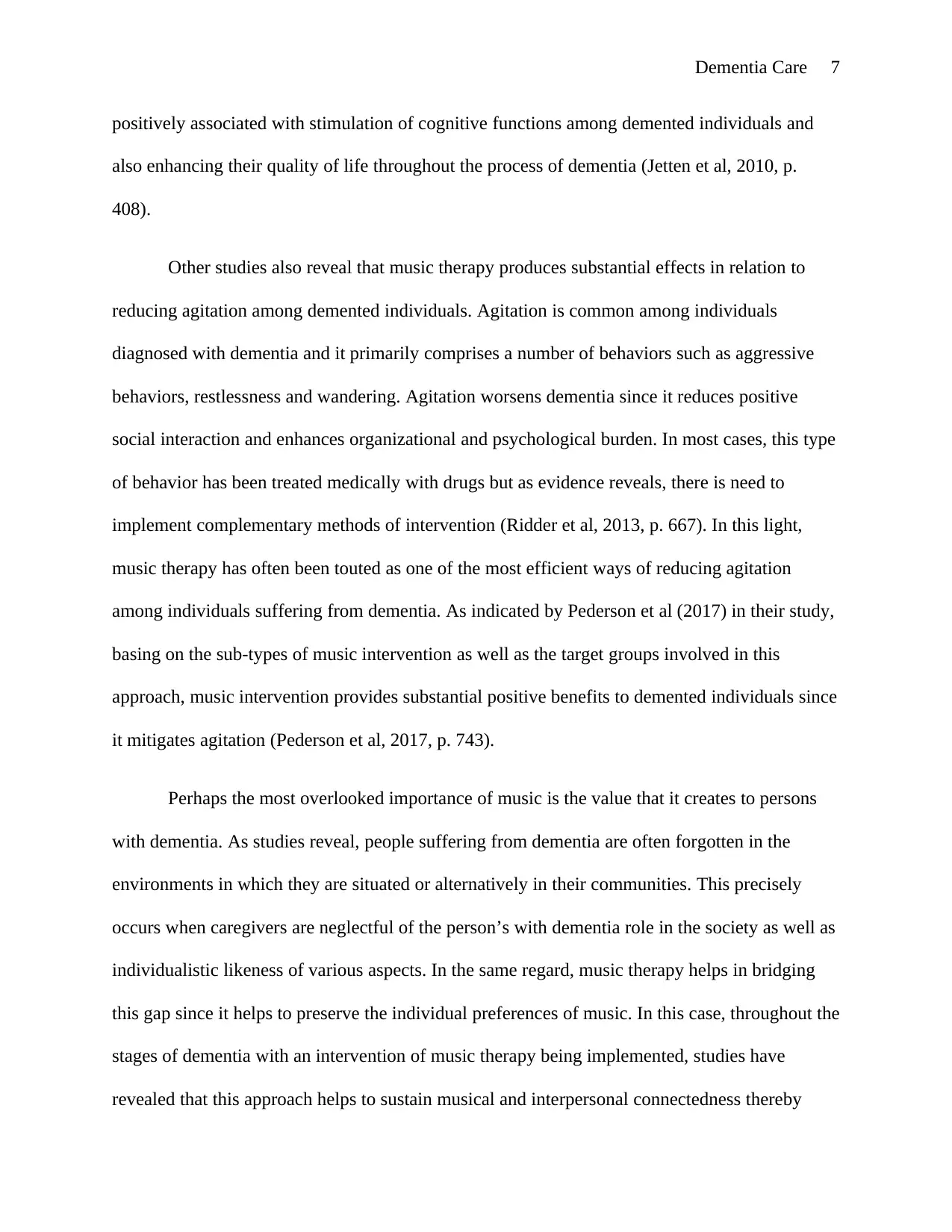
Dementia Care 7
positively associated with stimulation of cognitive functions among demented individuals and
also enhancing their quality of life throughout the process of dementia (Jetten et al, 2010, p.
408).
Other studies also reveal that music therapy produces substantial effects in relation to
reducing agitation among demented individuals. Agitation is common among individuals
diagnosed with dementia and it primarily comprises a number of behaviors such as aggressive
behaviors, restlessness and wandering. Agitation worsens dementia since it reduces positive
social interaction and enhances organizational and psychological burden. In most cases, this type
of behavior has been treated medically with drugs but as evidence reveals, there is need to
implement complementary methods of intervention (Ridder et al, 2013, p. 667). In this light,
music therapy has often been touted as one of the most efficient ways of reducing agitation
among individuals suffering from dementia. As indicated by Pederson et al (2017) in their study,
basing on the sub-types of music intervention as well as the target groups involved in this
approach, music intervention provides substantial positive benefits to demented individuals since
it mitigates agitation (Pederson et al, 2017, p. 743).
Perhaps the most overlooked importance of music is the value that it creates to persons
with dementia. As studies reveal, people suffering from dementia are often forgotten in the
environments in which they are situated or alternatively in their communities. This precisely
occurs when caregivers are neglectful of the person’s with dementia role in the society as well as
individualistic likeness of various aspects. In the same regard, music therapy helps in bridging
this gap since it helps to preserve the individual preferences of music. In this case, throughout the
stages of dementia with an intervention of music therapy being implemented, studies have
revealed that this approach helps to sustain musical and interpersonal connectedness thereby
positively associated with stimulation of cognitive functions among demented individuals and
also enhancing their quality of life throughout the process of dementia (Jetten et al, 2010, p.
408).
Other studies also reveal that music therapy produces substantial effects in relation to
reducing agitation among demented individuals. Agitation is common among individuals
diagnosed with dementia and it primarily comprises a number of behaviors such as aggressive
behaviors, restlessness and wandering. Agitation worsens dementia since it reduces positive
social interaction and enhances organizational and psychological burden. In most cases, this type
of behavior has been treated medically with drugs but as evidence reveals, there is need to
implement complementary methods of intervention (Ridder et al, 2013, p. 667). In this light,
music therapy has often been touted as one of the most efficient ways of reducing agitation
among individuals suffering from dementia. As indicated by Pederson et al (2017) in their study,
basing on the sub-types of music intervention as well as the target groups involved in this
approach, music intervention provides substantial positive benefits to demented individuals since
it mitigates agitation (Pederson et al, 2017, p. 743).
Perhaps the most overlooked importance of music is the value that it creates to persons
with dementia. As studies reveal, people suffering from dementia are often forgotten in the
environments in which they are situated or alternatively in their communities. This precisely
occurs when caregivers are neglectful of the person’s with dementia role in the society as well as
individualistic likeness of various aspects. In the same regard, music therapy helps in bridging
this gap since it helps to preserve the individual preferences of music. In this case, throughout the
stages of dementia with an intervention of music therapy being implemented, studies have
revealed that this approach helps to sustain musical and interpersonal connectedness thereby
Paraphrase This Document
Need a fresh take? Get an instant paraphrase of this document with our AI Paraphraser
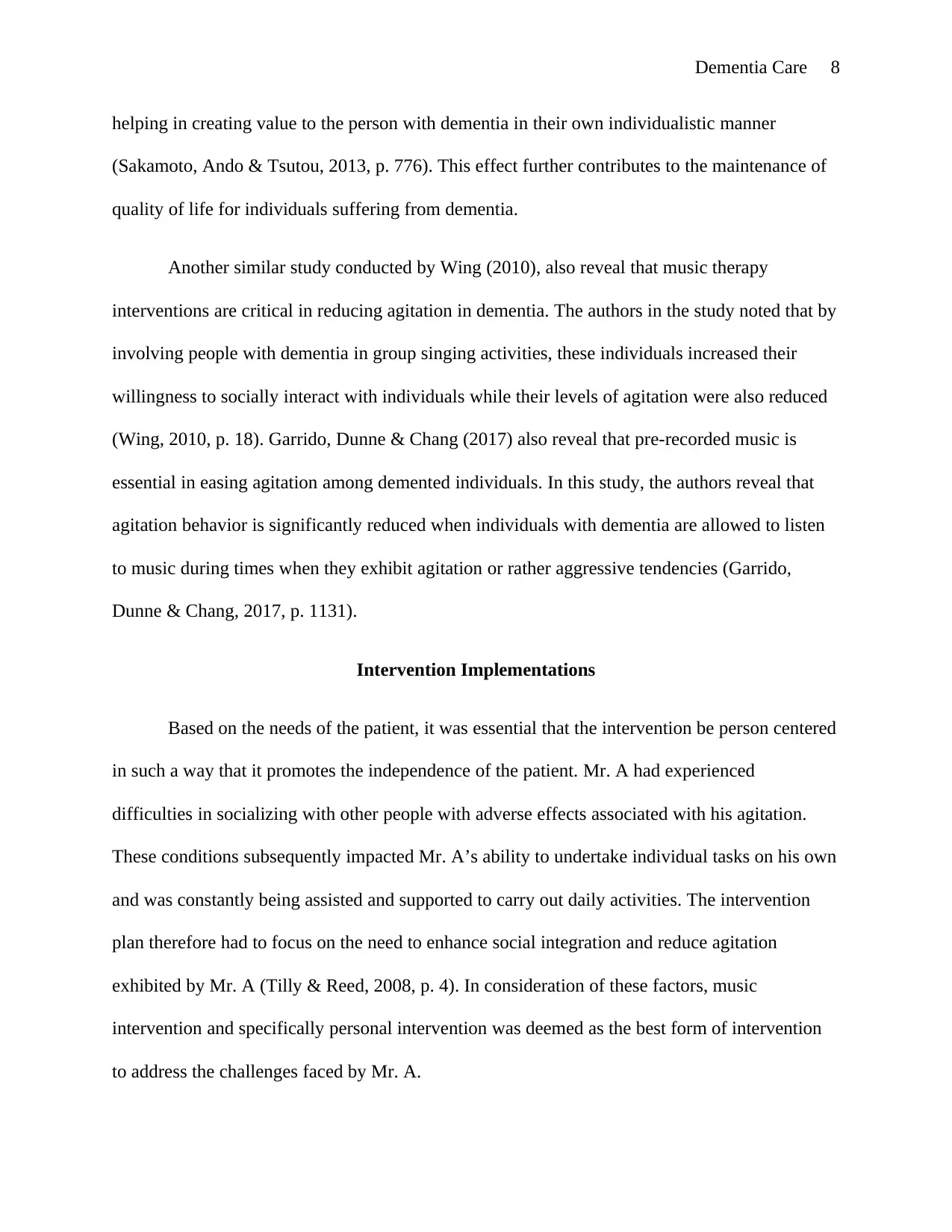
Dementia Care 8
helping in creating value to the person with dementia in their own individualistic manner
(Sakamoto, Ando & Tsutou, 2013, p. 776). This effect further contributes to the maintenance of
quality of life for individuals suffering from dementia.
Another similar study conducted by Wing (2010), also reveal that music therapy
interventions are critical in reducing agitation in dementia. The authors in the study noted that by
involving people with dementia in group singing activities, these individuals increased their
willingness to socially interact with individuals while their levels of agitation were also reduced
(Wing, 2010, p. 18). Garrido, Dunne & Chang (2017) also reveal that pre-recorded music is
essential in easing agitation among demented individuals. In this study, the authors reveal that
agitation behavior is significantly reduced when individuals with dementia are allowed to listen
to music during times when they exhibit agitation or rather aggressive tendencies (Garrido,
Dunne & Chang, 2017, p. 1131).
Intervention Implementations
Based on the needs of the patient, it was essential that the intervention be person centered
in such a way that it promotes the independence of the patient. Mr. A had experienced
difficulties in socializing with other people with adverse effects associated with his agitation.
These conditions subsequently impacted Mr. A’s ability to undertake individual tasks on his own
and was constantly being assisted and supported to carry out daily activities. The intervention
plan therefore had to focus on the need to enhance social integration and reduce agitation
exhibited by Mr. A (Tilly & Reed, 2008, p. 4). In consideration of these factors, music
intervention and specifically personal intervention was deemed as the best form of intervention
to address the challenges faced by Mr. A.
helping in creating value to the person with dementia in their own individualistic manner
(Sakamoto, Ando & Tsutou, 2013, p. 776). This effect further contributes to the maintenance of
quality of life for individuals suffering from dementia.
Another similar study conducted by Wing (2010), also reveal that music therapy
interventions are critical in reducing agitation in dementia. The authors in the study noted that by
involving people with dementia in group singing activities, these individuals increased their
willingness to socially interact with individuals while their levels of agitation were also reduced
(Wing, 2010, p. 18). Garrido, Dunne & Chang (2017) also reveal that pre-recorded music is
essential in easing agitation among demented individuals. In this study, the authors reveal that
agitation behavior is significantly reduced when individuals with dementia are allowed to listen
to music during times when they exhibit agitation or rather aggressive tendencies (Garrido,
Dunne & Chang, 2017, p. 1131).
Intervention Implementations
Based on the needs of the patient, it was essential that the intervention be person centered
in such a way that it promotes the independence of the patient. Mr. A had experienced
difficulties in socializing with other people with adverse effects associated with his agitation.
These conditions subsequently impacted Mr. A’s ability to undertake individual tasks on his own
and was constantly being assisted and supported to carry out daily activities. The intervention
plan therefore had to focus on the need to enhance social integration and reduce agitation
exhibited by Mr. A (Tilly & Reed, 2008, p. 4). In consideration of these factors, music
intervention and specifically personal intervention was deemed as the best form of intervention
to address the challenges faced by Mr. A.
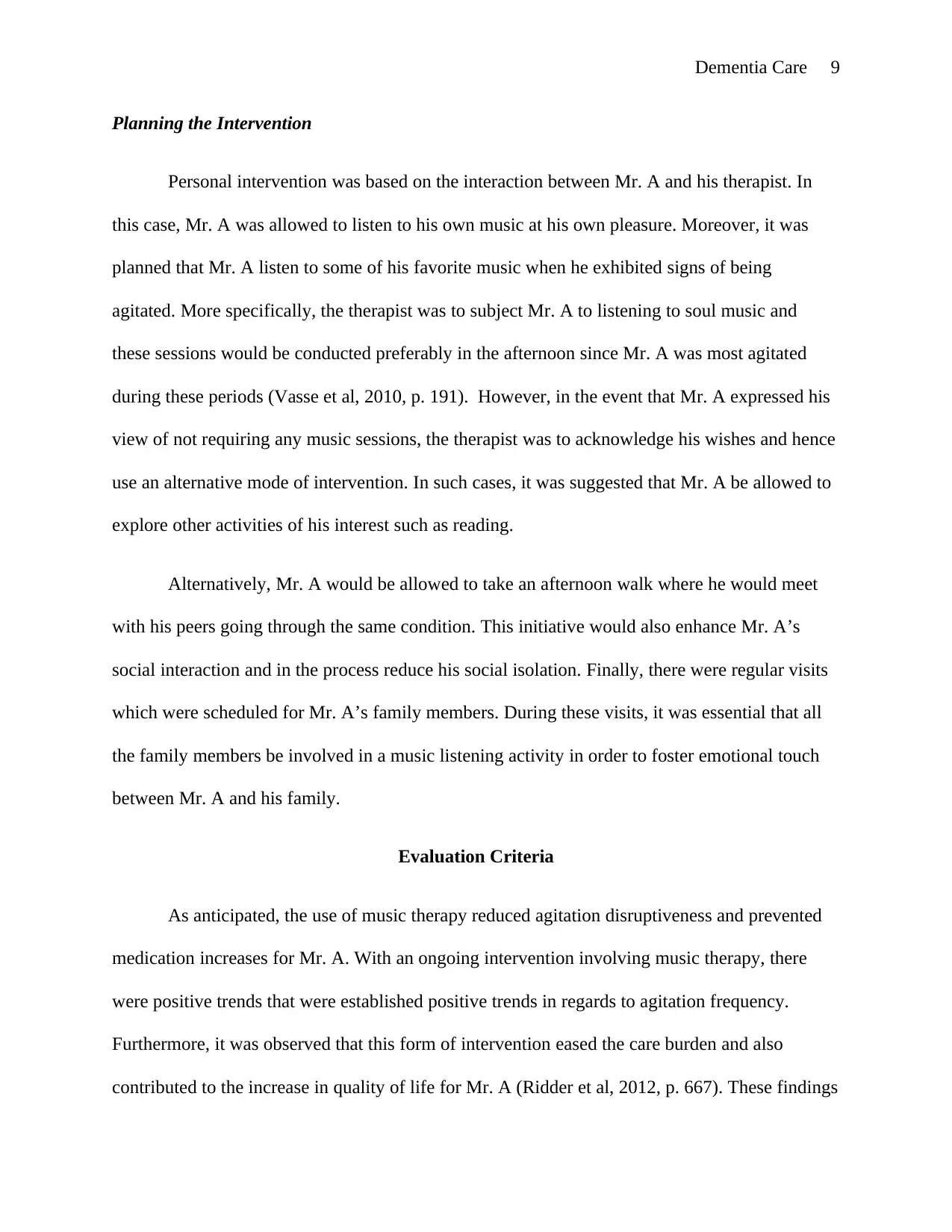
Dementia Care 9
Planning the Intervention
Personal intervention was based on the interaction between Mr. A and his therapist. In
this case, Mr. A was allowed to listen to his own music at his own pleasure. Moreover, it was
planned that Mr. A listen to some of his favorite music when he exhibited signs of being
agitated. More specifically, the therapist was to subject Mr. A to listening to soul music and
these sessions would be conducted preferably in the afternoon since Mr. A was most agitated
during these periods (Vasse et al, 2010, p. 191). However, in the event that Mr. A expressed his
view of not requiring any music sessions, the therapist was to acknowledge his wishes and hence
use an alternative mode of intervention. In such cases, it was suggested that Mr. A be allowed to
explore other activities of his interest such as reading.
Alternatively, Mr. A would be allowed to take an afternoon walk where he would meet
with his peers going through the same condition. This initiative would also enhance Mr. A’s
social interaction and in the process reduce his social isolation. Finally, there were regular visits
which were scheduled for Mr. A’s family members. During these visits, it was essential that all
the family members be involved in a music listening activity in order to foster emotional touch
between Mr. A and his family.
Evaluation Criteria
As anticipated, the use of music therapy reduced agitation disruptiveness and prevented
medication increases for Mr. A. With an ongoing intervention involving music therapy, there
were positive trends that were established positive trends in regards to agitation frequency.
Furthermore, it was observed that this form of intervention eased the care burden and also
contributed to the increase in quality of life for Mr. A (Ridder et al, 2012, p. 667). These findings
Planning the Intervention
Personal intervention was based on the interaction between Mr. A and his therapist. In
this case, Mr. A was allowed to listen to his own music at his own pleasure. Moreover, it was
planned that Mr. A listen to some of his favorite music when he exhibited signs of being
agitated. More specifically, the therapist was to subject Mr. A to listening to soul music and
these sessions would be conducted preferably in the afternoon since Mr. A was most agitated
during these periods (Vasse et al, 2010, p. 191). However, in the event that Mr. A expressed his
view of not requiring any music sessions, the therapist was to acknowledge his wishes and hence
use an alternative mode of intervention. In such cases, it was suggested that Mr. A be allowed to
explore other activities of his interest such as reading.
Alternatively, Mr. A would be allowed to take an afternoon walk where he would meet
with his peers going through the same condition. This initiative would also enhance Mr. A’s
social interaction and in the process reduce his social isolation. Finally, there were regular visits
which were scheduled for Mr. A’s family members. During these visits, it was essential that all
the family members be involved in a music listening activity in order to foster emotional touch
between Mr. A and his family.
Evaluation Criteria
As anticipated, the use of music therapy reduced agitation disruptiveness and prevented
medication increases for Mr. A. With an ongoing intervention involving music therapy, there
were positive trends that were established positive trends in regards to agitation frequency.
Furthermore, it was observed that this form of intervention eased the care burden and also
contributed to the increase in quality of life for Mr. A (Ridder et al, 2012, p. 667). These findings
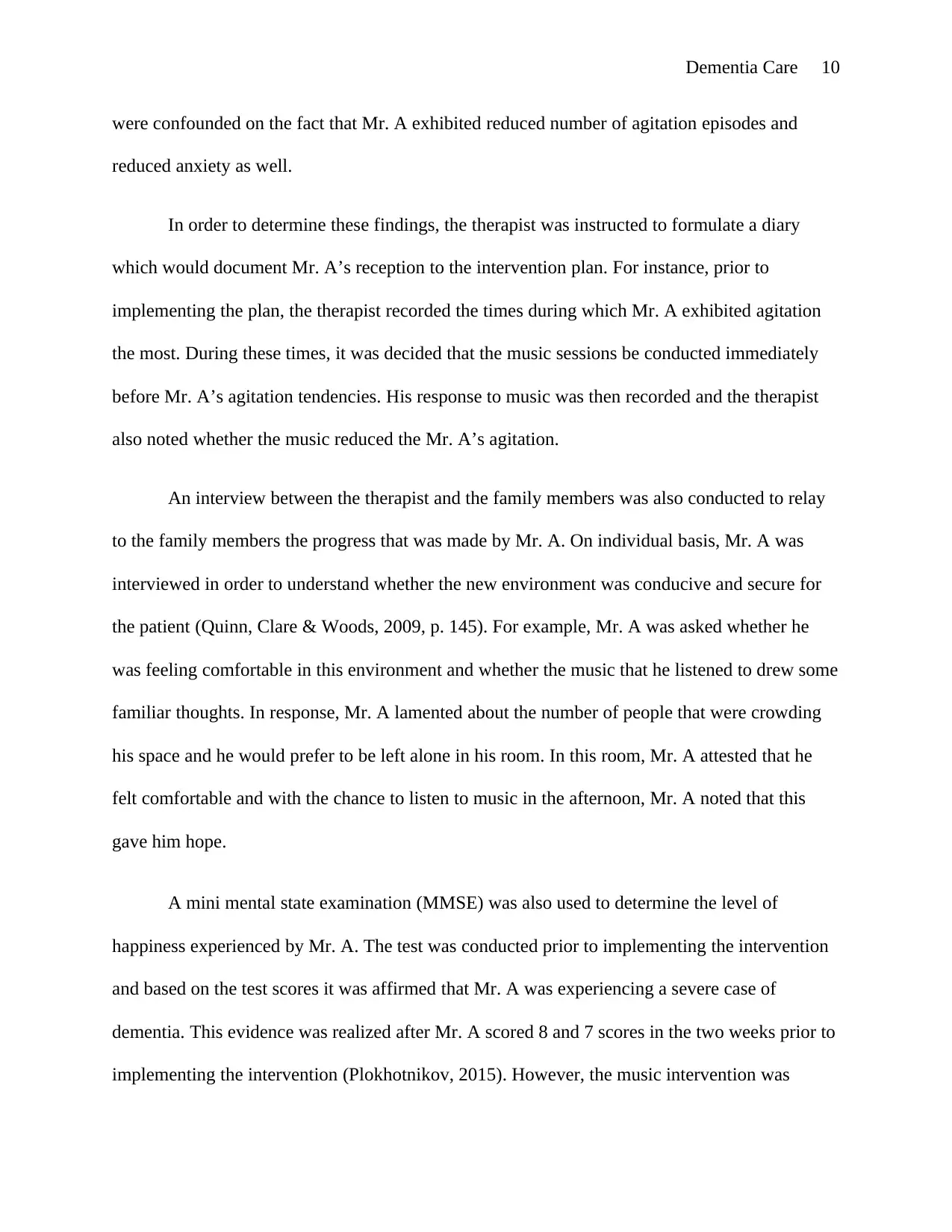
Dementia Care 10
were confounded on the fact that Mr. A exhibited reduced number of agitation episodes and
reduced anxiety as well.
In order to determine these findings, the therapist was instructed to formulate a diary
which would document Mr. A’s reception to the intervention plan. For instance, prior to
implementing the plan, the therapist recorded the times during which Mr. A exhibited agitation
the most. During these times, it was decided that the music sessions be conducted immediately
before Mr. A’s agitation tendencies. His response to music was then recorded and the therapist
also noted whether the music reduced the Mr. A’s agitation.
An interview between the therapist and the family members was also conducted to relay
to the family members the progress that was made by Mr. A. On individual basis, Mr. A was
interviewed in order to understand whether the new environment was conducive and secure for
the patient (Quinn, Clare & Woods, 2009, p. 145). For example, Mr. A was asked whether he
was feeling comfortable in this environment and whether the music that he listened to drew some
familiar thoughts. In response, Mr. A lamented about the number of people that were crowding
his space and he would prefer to be left alone in his room. In this room, Mr. A attested that he
felt comfortable and with the chance to listen to music in the afternoon, Mr. A noted that this
gave him hope.
A mini mental state examination (MMSE) was also used to determine the level of
happiness experienced by Mr. A. The test was conducted prior to implementing the intervention
and based on the test scores it was affirmed that Mr. A was experiencing a severe case of
dementia. This evidence was realized after Mr. A scored 8 and 7 scores in the two weeks prior to
implementing the intervention (Plokhotnikov, 2015). However, the music intervention was
were confounded on the fact that Mr. A exhibited reduced number of agitation episodes and
reduced anxiety as well.
In order to determine these findings, the therapist was instructed to formulate a diary
which would document Mr. A’s reception to the intervention plan. For instance, prior to
implementing the plan, the therapist recorded the times during which Mr. A exhibited agitation
the most. During these times, it was decided that the music sessions be conducted immediately
before Mr. A’s agitation tendencies. His response to music was then recorded and the therapist
also noted whether the music reduced the Mr. A’s agitation.
An interview between the therapist and the family members was also conducted to relay
to the family members the progress that was made by Mr. A. On individual basis, Mr. A was
interviewed in order to understand whether the new environment was conducive and secure for
the patient (Quinn, Clare & Woods, 2009, p. 145). For example, Mr. A was asked whether he
was feeling comfortable in this environment and whether the music that he listened to drew some
familiar thoughts. In response, Mr. A lamented about the number of people that were crowding
his space and he would prefer to be left alone in his room. In this room, Mr. A attested that he
felt comfortable and with the chance to listen to music in the afternoon, Mr. A noted that this
gave him hope.
A mini mental state examination (MMSE) was also used to determine the level of
happiness experienced by Mr. A. The test was conducted prior to implementing the intervention
and based on the test scores it was affirmed that Mr. A was experiencing a severe case of
dementia. This evidence was realized after Mr. A scored 8 and 7 scores in the two weeks prior to
implementing the intervention (Plokhotnikov, 2015). However, the music intervention was
Secure Best Marks with AI Grader
Need help grading? Try our AI Grader for instant feedback on your assignments.
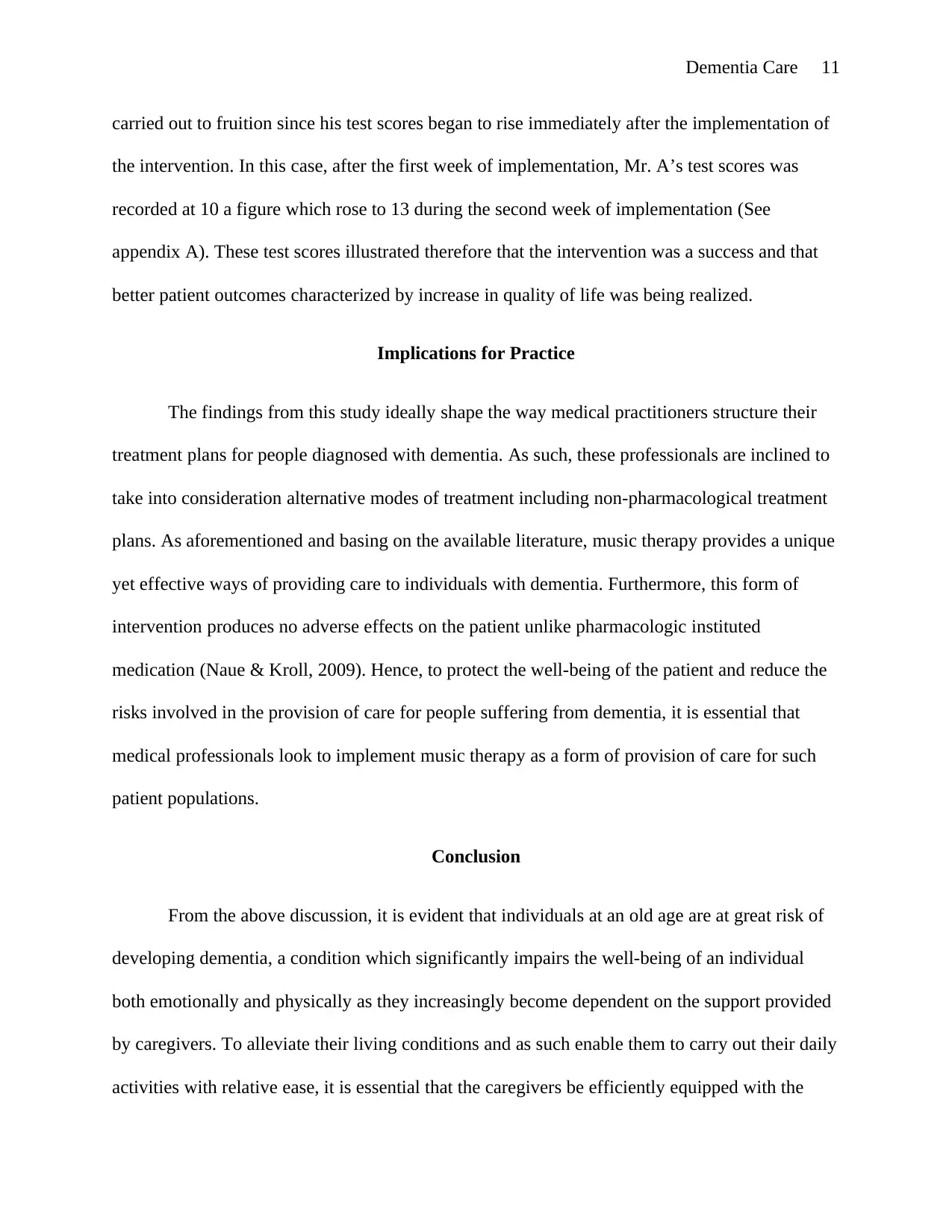
Dementia Care 11
carried out to fruition since his test scores began to rise immediately after the implementation of
the intervention. In this case, after the first week of implementation, Mr. A’s test scores was
recorded at 10 a figure which rose to 13 during the second week of implementation (See
appendix A). These test scores illustrated therefore that the intervention was a success and that
better patient outcomes characterized by increase in quality of life was being realized.
Implications for Practice
The findings from this study ideally shape the way medical practitioners structure their
treatment plans for people diagnosed with dementia. As such, these professionals are inclined to
take into consideration alternative modes of treatment including non-pharmacological treatment
plans. As aforementioned and basing on the available literature, music therapy provides a unique
yet effective ways of providing care to individuals with dementia. Furthermore, this form of
intervention produces no adverse effects on the patient unlike pharmacologic instituted
medication (Naue & Kroll, 2009). Hence, to protect the well-being of the patient and reduce the
risks involved in the provision of care for people suffering from dementia, it is essential that
medical professionals look to implement music therapy as a form of provision of care for such
patient populations.
Conclusion
From the above discussion, it is evident that individuals at an old age are at great risk of
developing dementia, a condition which significantly impairs the well-being of an individual
both emotionally and physically as they increasingly become dependent on the support provided
by caregivers. To alleviate their living conditions and as such enable them to carry out their daily
activities with relative ease, it is essential that the caregivers be efficiently equipped with the
carried out to fruition since his test scores began to rise immediately after the implementation of
the intervention. In this case, after the first week of implementation, Mr. A’s test scores was
recorded at 10 a figure which rose to 13 during the second week of implementation (See
appendix A). These test scores illustrated therefore that the intervention was a success and that
better patient outcomes characterized by increase in quality of life was being realized.
Implications for Practice
The findings from this study ideally shape the way medical practitioners structure their
treatment plans for people diagnosed with dementia. As such, these professionals are inclined to
take into consideration alternative modes of treatment including non-pharmacological treatment
plans. As aforementioned and basing on the available literature, music therapy provides a unique
yet effective ways of providing care to individuals with dementia. Furthermore, this form of
intervention produces no adverse effects on the patient unlike pharmacologic instituted
medication (Naue & Kroll, 2009). Hence, to protect the well-being of the patient and reduce the
risks involved in the provision of care for people suffering from dementia, it is essential that
medical professionals look to implement music therapy as a form of provision of care for such
patient populations.
Conclusion
From the above discussion, it is evident that individuals at an old age are at great risk of
developing dementia, a condition which significantly impairs the well-being of an individual
both emotionally and physically as they increasingly become dependent on the support provided
by caregivers. To alleviate their living conditions and as such enable them to carry out their daily
activities with relative ease, it is essential that the caregivers be efficiently equipped with the
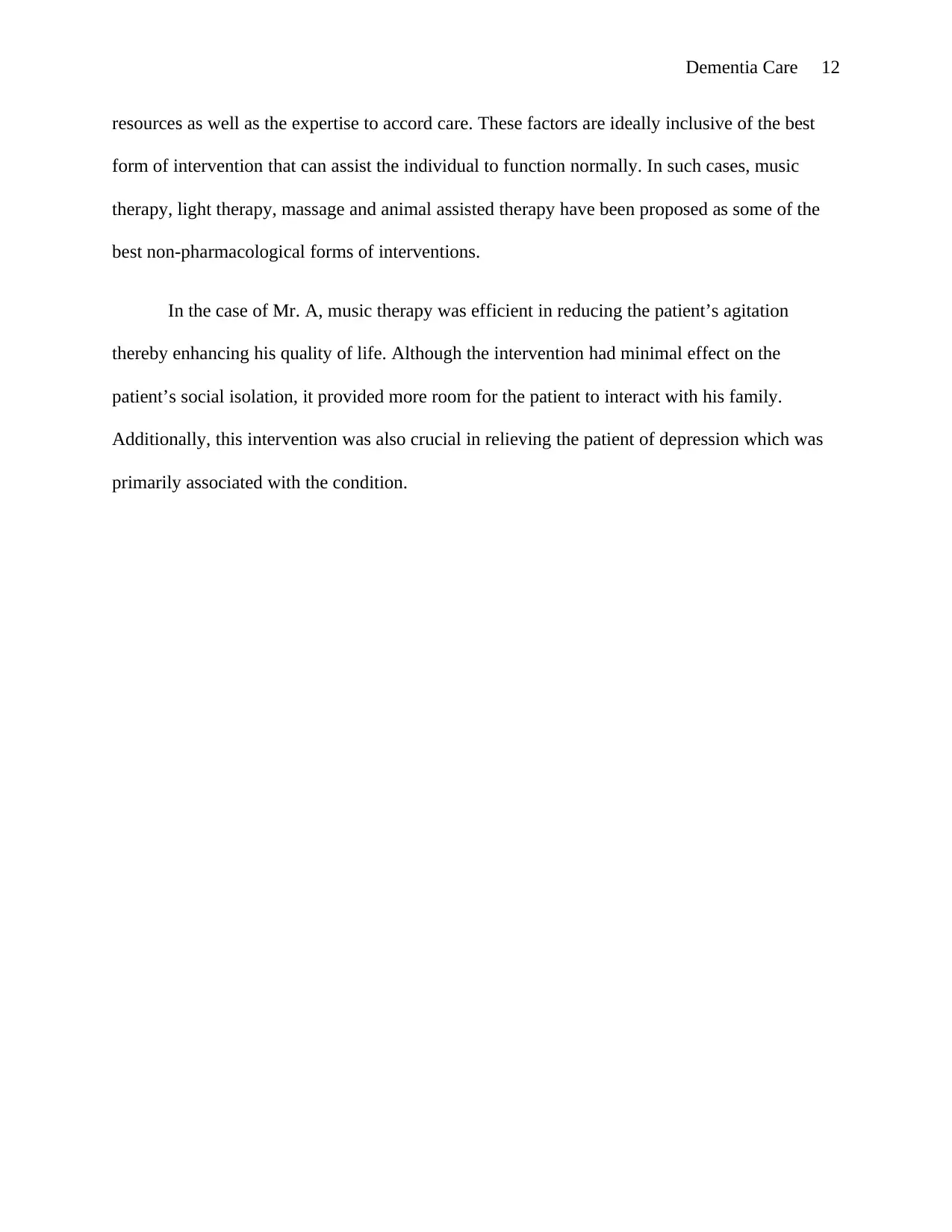
Dementia Care 12
resources as well as the expertise to accord care. These factors are ideally inclusive of the best
form of intervention that can assist the individual to function normally. In such cases, music
therapy, light therapy, massage and animal assisted therapy have been proposed as some of the
best non-pharmacological forms of interventions.
In the case of Mr. A, music therapy was efficient in reducing the patient’s agitation
thereby enhancing his quality of life. Although the intervention had minimal effect on the
patient’s social isolation, it provided more room for the patient to interact with his family.
Additionally, this intervention was also crucial in relieving the patient of depression which was
primarily associated with the condition.
resources as well as the expertise to accord care. These factors are ideally inclusive of the best
form of intervention that can assist the individual to function normally. In such cases, music
therapy, light therapy, massage and animal assisted therapy have been proposed as some of the
best non-pharmacological forms of interventions.
In the case of Mr. A, music therapy was efficient in reducing the patient’s agitation
thereby enhancing his quality of life. Although the intervention had minimal effect on the
patient’s social isolation, it provided more room for the patient to interact with his family.
Additionally, this intervention was also crucial in relieving the patient of depression which was
primarily associated with the condition.

Dementia Care 13
References
Buettner, L., Lundedren, H., Lago, D., Farrell, P., & Smith, R. (2016) Therapeutic Recreation as
an Intervention for Nursing Home Residents with Dementia and Agitation: An Efficacy Study.
American Journal of Alzheimer’s Disease. 11(5), pp. 4-12.
Forbes, D. A., & Neufeld, A. (2008) Looming Dementia Care Crisis: Canada Needs an
Integrated Model of Continuing Care Now. Canadian Journal of Nursing Research. 40, pp. 9-16.
Garrido, S., Dunne, L., & Chang, E. (2017) The Use of Music Playlists for People with
Dementia: A Critical Synthesis. Journal of Alzheimer’s Disease, 60(3), pp. 1129-1142.
Gerdner, L. A., & McBride, M. R. (2015) Individualized Music Intervention for Agitation in
Dementia Care and Disaster Preparedness. HSOA Journal of Gerontology & Geriatric Medicine.
1(5), pp. 1-4.
Jetten, J., Haslam, C., Pugliese, C., & Haslam, S. A. (2010). Declining Autobiographical
Memory and the Loss of Identity: Effects on Well-being. Journal of Clinical and Experimental
Neuropsychology. 32, 408-416.
Kitwood, T. 1993. Person and Process in Dementia. International Journal of Geriatric
Psychiatry. 8(7), pp. 541-545.
McDermott, O., Orrell, M., & Ridder, H. M. (2014) The Importance of Music for People with
Dementia: The Perspectives of People with Dementia, Family Carers, Staff and Music
Therapists. Aging and Mental Health. 18(6), 706-716.
Naue, U., & Kroll, T. (2009) The Demented Other: Identity and Difference in Dementia. Nursing
Philosophy. 10, 26-33.
References
Buettner, L., Lundedren, H., Lago, D., Farrell, P., & Smith, R. (2016) Therapeutic Recreation as
an Intervention for Nursing Home Residents with Dementia and Agitation: An Efficacy Study.
American Journal of Alzheimer’s Disease. 11(5), pp. 4-12.
Forbes, D. A., & Neufeld, A. (2008) Looming Dementia Care Crisis: Canada Needs an
Integrated Model of Continuing Care Now. Canadian Journal of Nursing Research. 40, pp. 9-16.
Garrido, S., Dunne, L., & Chang, E. (2017) The Use of Music Playlists for People with
Dementia: A Critical Synthesis. Journal of Alzheimer’s Disease, 60(3), pp. 1129-1142.
Gerdner, L. A., & McBride, M. R. (2015) Individualized Music Intervention for Agitation in
Dementia Care and Disaster Preparedness. HSOA Journal of Gerontology & Geriatric Medicine.
1(5), pp. 1-4.
Jetten, J., Haslam, C., Pugliese, C., & Haslam, S. A. (2010). Declining Autobiographical
Memory and the Loss of Identity: Effects on Well-being. Journal of Clinical and Experimental
Neuropsychology. 32, 408-416.
Kitwood, T. 1993. Person and Process in Dementia. International Journal of Geriatric
Psychiatry. 8(7), pp. 541-545.
McDermott, O., Orrell, M., & Ridder, H. M. (2014) The Importance of Music for People with
Dementia: The Perspectives of People with Dementia, Family Carers, Staff and Music
Therapists. Aging and Mental Health. 18(6), 706-716.
Naue, U., & Kroll, T. (2009) The Demented Other: Identity and Difference in Dementia. Nursing
Philosophy. 10, 26-33.
Paraphrase This Document
Need a fresh take? Get an instant paraphrase of this document with our AI Paraphraser
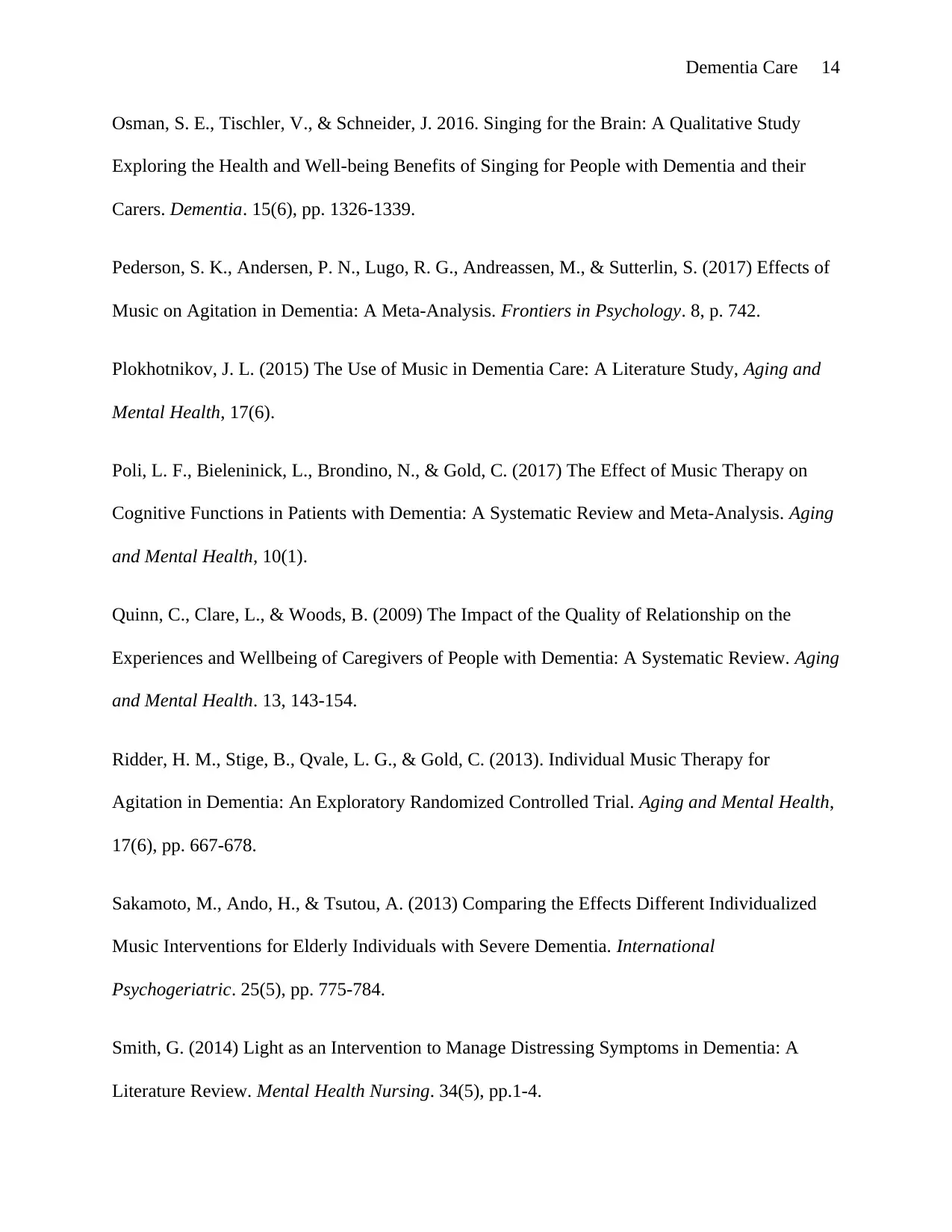
Dementia Care 14
Osman, S. E., Tischler, V., & Schneider, J. 2016. Singing for the Brain: A Qualitative Study
Exploring the Health and Well-being Benefits of Singing for People with Dementia and their
Carers. Dementia. 15(6), pp. 1326-1339.
Pederson, S. K., Andersen, P. N., Lugo, R. G., Andreassen, M., & Sutterlin, S. (2017) Effects of
Music on Agitation in Dementia: A Meta-Analysis. Frontiers in Psychology. 8, p. 742.
Plokhotnikov, J. L. (2015) The Use of Music in Dementia Care: A Literature Study, Aging and
Mental Health, 17(6).
Poli, L. F., Bieleninick, L., Brondino, N., & Gold, C. (2017) The Effect of Music Therapy on
Cognitive Functions in Patients with Dementia: A Systematic Review and Meta-Analysis. Aging
and Mental Health, 10(1).
Quinn, C., Clare, L., & Woods, B. (2009) The Impact of the Quality of Relationship on the
Experiences and Wellbeing of Caregivers of People with Dementia: A Systematic Review. Aging
and Mental Health. 13, 143-154.
Ridder, H. M., Stige, B., Qvale, L. G., & Gold, C. (2013). Individual Music Therapy for
Agitation in Dementia: An Exploratory Randomized Controlled Trial. Aging and Mental Health,
17(6), pp. 667-678.
Sakamoto, M., Ando, H., & Tsutou, A. (2013) Comparing the Effects Different Individualized
Music Interventions for Elderly Individuals with Severe Dementia. International
Psychogeriatric. 25(5), pp. 775-784.
Smith, G. (2014) Light as an Intervention to Manage Distressing Symptoms in Dementia: A
Literature Review. Mental Health Nursing. 34(5), pp.1-4.
Osman, S. E., Tischler, V., & Schneider, J. 2016. Singing for the Brain: A Qualitative Study
Exploring the Health and Well-being Benefits of Singing for People with Dementia and their
Carers. Dementia. 15(6), pp. 1326-1339.
Pederson, S. K., Andersen, P. N., Lugo, R. G., Andreassen, M., & Sutterlin, S. (2017) Effects of
Music on Agitation in Dementia: A Meta-Analysis. Frontiers in Psychology. 8, p. 742.
Plokhotnikov, J. L. (2015) The Use of Music in Dementia Care: A Literature Study, Aging and
Mental Health, 17(6).
Poli, L. F., Bieleninick, L., Brondino, N., & Gold, C. (2017) The Effect of Music Therapy on
Cognitive Functions in Patients with Dementia: A Systematic Review and Meta-Analysis. Aging
and Mental Health, 10(1).
Quinn, C., Clare, L., & Woods, B. (2009) The Impact of the Quality of Relationship on the
Experiences and Wellbeing of Caregivers of People with Dementia: A Systematic Review. Aging
and Mental Health. 13, 143-154.
Ridder, H. M., Stige, B., Qvale, L. G., & Gold, C. (2013). Individual Music Therapy for
Agitation in Dementia: An Exploratory Randomized Controlled Trial. Aging and Mental Health,
17(6), pp. 667-678.
Sakamoto, M., Ando, H., & Tsutou, A. (2013) Comparing the Effects Different Individualized
Music Interventions for Elderly Individuals with Severe Dementia. International
Psychogeriatric. 25(5), pp. 775-784.
Smith, G. (2014) Light as an Intervention to Manage Distressing Symptoms in Dementia: A
Literature Review. Mental Health Nursing. 34(5), pp.1-4.
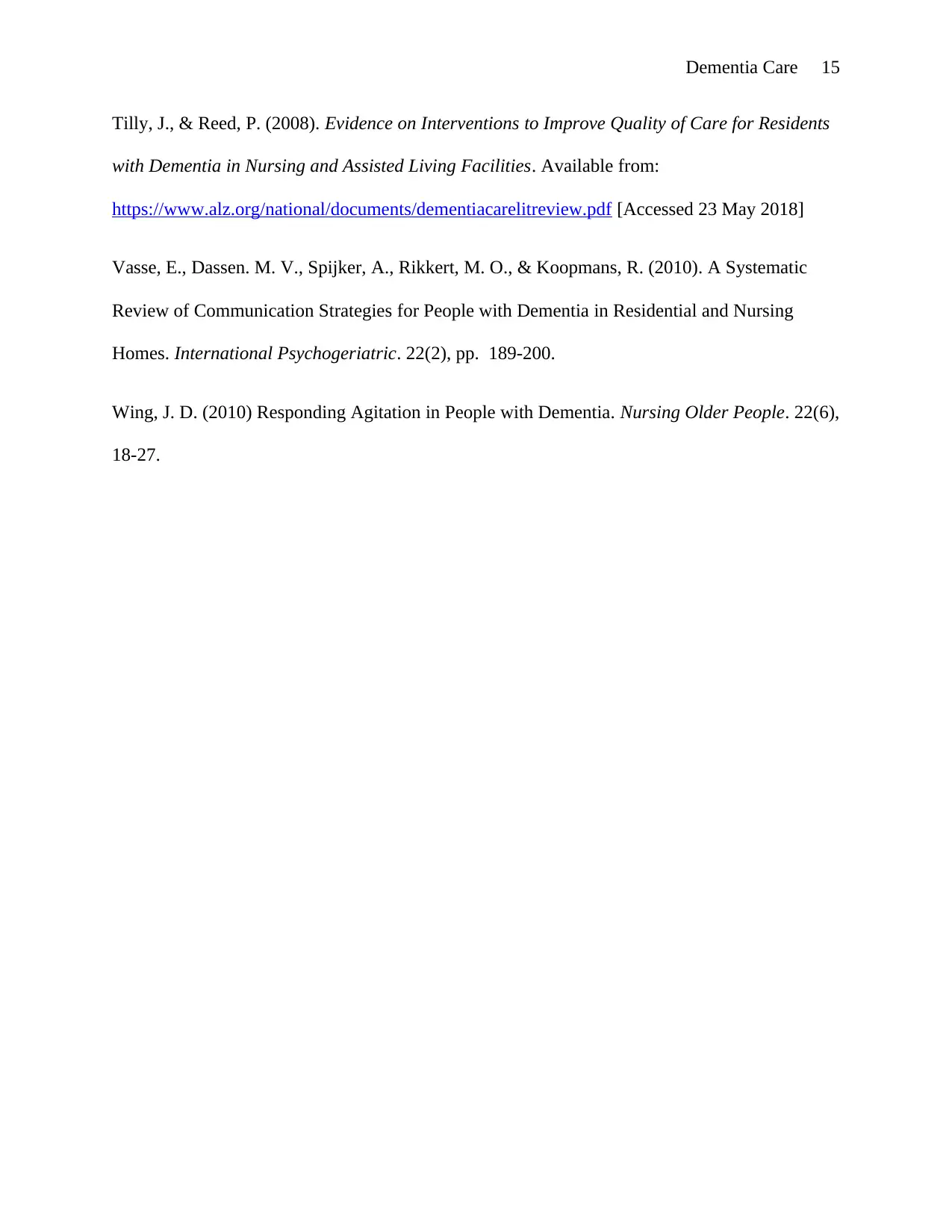
Dementia Care 15
Tilly, J., & Reed, P. (2008). Evidence on Interventions to Improve Quality of Care for Residents
with Dementia in Nursing and Assisted Living Facilities. Available from:
https://www.alz.org/national/documents/dementiacarelitreview.pdf [Accessed 23 May 2018]
Vasse, E., Dassen. M. V., Spijker, A., Rikkert, M. O., & Koopmans, R. (2010). A Systematic
Review of Communication Strategies for People with Dementia in Residential and Nursing
Homes. International Psychogeriatric. 22(2), pp. 189-200.
Wing, J. D. (2010) Responding Agitation in People with Dementia. Nursing Older People. 22(6),
18-27.
Tilly, J., & Reed, P. (2008). Evidence on Interventions to Improve Quality of Care for Residents
with Dementia in Nursing and Assisted Living Facilities. Available from:
https://www.alz.org/national/documents/dementiacarelitreview.pdf [Accessed 23 May 2018]
Vasse, E., Dassen. M. V., Spijker, A., Rikkert, M. O., & Koopmans, R. (2010). A Systematic
Review of Communication Strategies for People with Dementia in Residential and Nursing
Homes. International Psychogeriatric. 22(2), pp. 189-200.
Wing, J. D. (2010) Responding Agitation in People with Dementia. Nursing Older People. 22(6),
18-27.
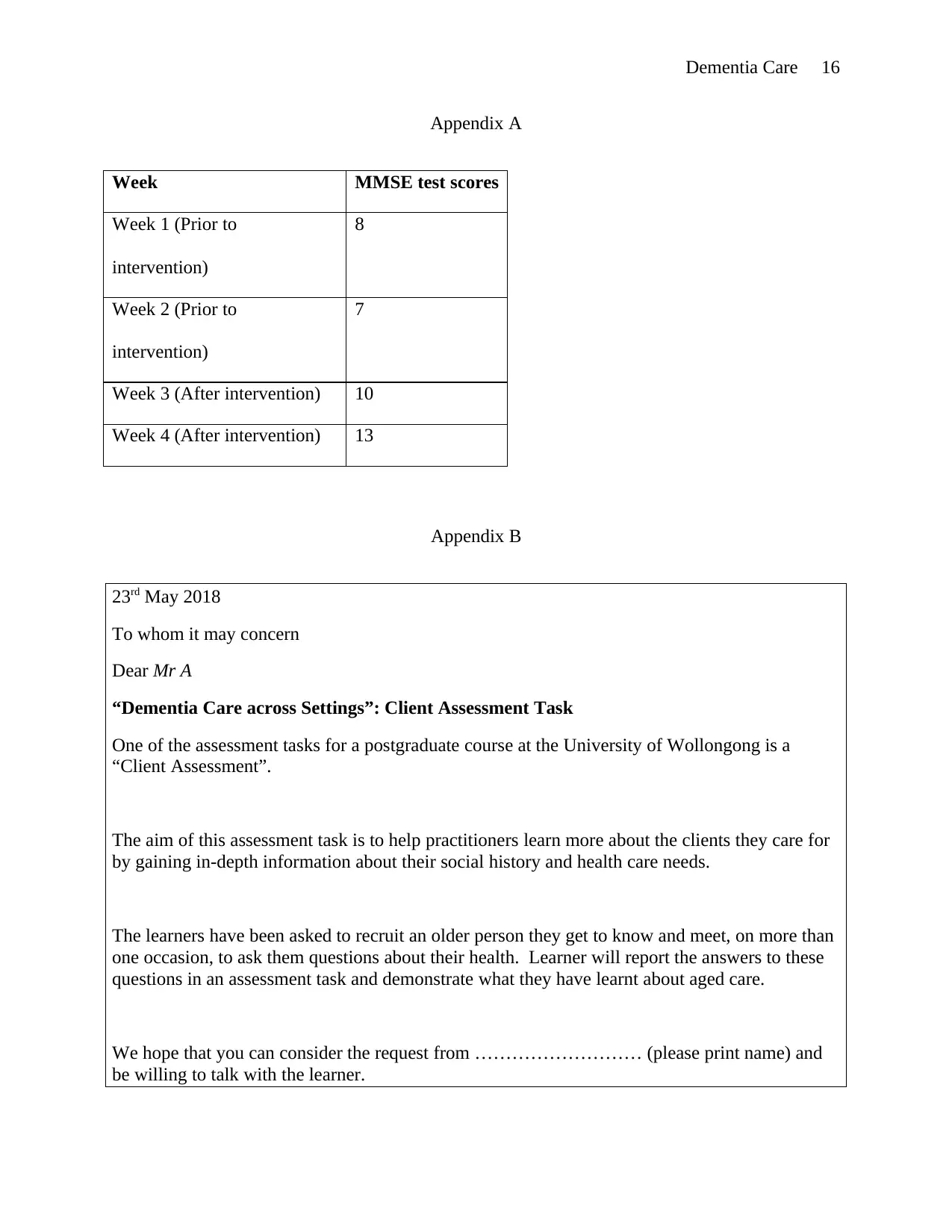
Dementia Care 16
Appendix A
Week MMSE test scores
Week 1 (Prior to
intervention)
8
Week 2 (Prior to
intervention)
7
Week 3 (After intervention) 10
Week 4 (After intervention) 13
Appendix B
23rd May 2018
To whom it may concern
Dear Mr A
“Dementia Care across Settings”: Client Assessment Task
One of the assessment tasks for a postgraduate course at the University of Wollongong is a
“Client Assessment”.
The aim of this assessment task is to help practitioners learn more about the clients they care for
by gaining in-depth information about their social history and health care needs.
The learners have been asked to recruit an older person they get to know and meet, on more than
one occasion, to ask them questions about their health. Learner will report the answers to these
questions in an assessment task and demonstrate what they have learnt about aged care.
We hope that you can consider the request from ……………………… (please print name) and
be willing to talk with the learner.
Appendix A
Week MMSE test scores
Week 1 (Prior to
intervention)
8
Week 2 (Prior to
intervention)
7
Week 3 (After intervention) 10
Week 4 (After intervention) 13
Appendix B
23rd May 2018
To whom it may concern
Dear Mr A
“Dementia Care across Settings”: Client Assessment Task
One of the assessment tasks for a postgraduate course at the University of Wollongong is a
“Client Assessment”.
The aim of this assessment task is to help practitioners learn more about the clients they care for
by gaining in-depth information about their social history and health care needs.
The learners have been asked to recruit an older person they get to know and meet, on more than
one occasion, to ask them questions about their health. Learner will report the answers to these
questions in an assessment task and demonstrate what they have learnt about aged care.
We hope that you can consider the request from ……………………… (please print name) and
be willing to talk with the learner.
Secure Best Marks with AI Grader
Need help grading? Try our AI Grader for instant feedback on your assignments.

Dementia Care 17
Thank you very much and if you have any questions please do not hesitate in contacting the
Course Co-ordinator:
Rita Chang
Lecturer (Rehabilitation, Continuing & Aged Care)
Telephone: 02 4221 3174
Fax: 02 4221 3137
Email: hchang@uow.edu.au
Thank you very much and if you have any questions please do not hesitate in contacting the
Course Co-ordinator:
Rita Chang
Lecturer (Rehabilitation, Continuing & Aged Care)
Telephone: 02 4221 3174
Fax: 02 4221 3137
Email: hchang@uow.edu.au
1 out of 17
Related Documents
Your All-in-One AI-Powered Toolkit for Academic Success.
+13062052269
info@desklib.com
Available 24*7 on WhatsApp / Email
![[object Object]](/_next/static/media/star-bottom.7253800d.svg)
Unlock your academic potential
© 2024 | Zucol Services PVT LTD | All rights reserved.





